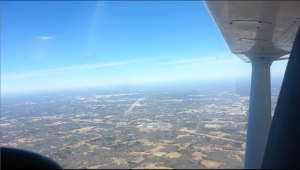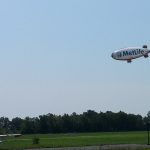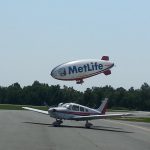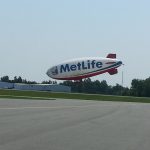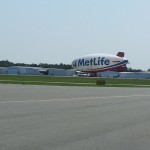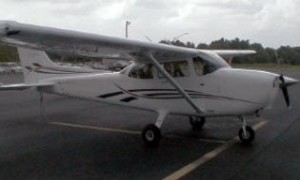First Night Flight
The first night flight was tonight, I arrived a little early and had to wait for sunset. Things looked very different but overall it wasn’t that bad.
First Cross-Country Solo
After cancelling many flights due to weather I finally completed my first cross-country solo this weekend. 56NM from wheels up to touchdown. 4500FT on the way there, 37min. 3500FT on the way back and only 25min, top ground speed was just short of 150MPH.
Next up is night flying, followed by a night cross-country, and then it’s just some practice and review prior to the check-ride. If the end of winter brings better weekend weather I should be able to finish soon.
Winter Update
Aviation: Winter is here and with it has come lots of overcast weather that’s no good for flight training, slowing progress quite a bit. In total I’ve now soloed 6-8 times and have started working on cross-country training. Cross-country flying adds many new elements: flight planning, talking to Air Traffic Control, radio navigation, visual navigation by waypoints, etc. All this has to be done while still flying the plane, so it’s definitely a challenge. Currently targeting to have my FAA checkride sometime before April.
Bus: Winter also puts a damper on bus driving since I don’t have the heat connected yet. On the last drive before the temperature dropped I had a big loss in power every few minutes and had to pull over and idle before power came back. I haven’t looked into it yet but this seems consistent with a clogged fuel filter; I was expecting the first filter to go quickly since it’s filtering out all the rust/varnish/trash from the fuel tank that sat for 30 years. I probably could swap the filter and have it going again but I think this is a good opportunity to now pull the engine/trans again and go through it with a fine-tooth comb with the goal of getting it smoother/quieter/stronger to enable longer trips. No immediate plans to do this, probably when the weather warms up.
Tech Projects: I just ordered a float valve to automate refilling the Keurig, I’ll post pictures of how that goes. Also I’m getting interested in making a small CNC machine; I’ve had this on my long-term to do list for a while but recently component prices have dropped substantially so I’ve started the planning process.
First Solo Flight!
Originally this weekend was to be my first solo flight. Sunday I showed the instructor 3 takeoffs, 3 landings, and got signed off to fly solo. Just as we taxied back to the ramp to let the instructor out though, the weather report changed and exceeded the limits that I’m signed off for (12knots total wind, up to 5knots crosswind component). Because of this, we delayed the actual solo until this evening after work.
So today I was back at the field and everything went well. There’s a tradition in aviation that when a student first solos the instructor cuts off the student’s shirt tail; supposedly this dates back to the early days of biplane aviation when the instructor sat behind the student and pulled on the student’s shirt tail to get attention. When I taxied back to the ramp my instructor was ready with scissors…
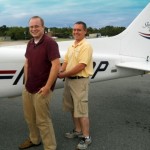
I’m told it goes relatively quickly from here but I know there’s a lot left to learn; I’ll now do some practicing on my own and then we’ll get into cross-country flying and procedures for ATC communication.
Blimp Encounter
Today I was back at the airport after nearly a month away from flying due to weather/maintenance/availability/etc. After takeoff I did some basic instrument flying. Instrument rating is a separate rating on top of the private pilot’s certificate. I’m not working on an instrument rating, but the basic instrument skills are taught/practiced anyways to have some level of familiarity in case I ever accidentally encounter instrument conditions. As I was doing the preflight, the MetLife blimp arrived at the field and we got to watch it land (if this is even the right word; it just got close to the ground and then a dozen guys ran out and grabbed the ropes). It was moored directly adjacent to the runway, so I got a few close-up glances while I was busy taking off and landing. After landing we heard them announce (their callsign was “Snoopy2”) a 5min warning for departure and by the time we got back to the ramp it was taking off.
Using a Real Aviation Headset with a PC Simulator
In parallel with real-world flight training I’ve begun to use a PC flight simulator more seriously. This reinforces what’s learned in the real plane and also allows me to practice flights ahead of time. The simulator is only vaguely analogous to real flying though, so the more I can do to make it realistic the better. One realism point would be to use the real aviation headset, but the headset does not directly plug into the PC. After a good bit of research cross-referencing part numbers and checking schematics, I came to two critical conclusions:
#1 – Standard 1/4″ mono audio dimensions are the same as general aviation headset plug dimensions. (The speaker plug, not the microphone plug)
#2 – The sound card output levels are compatible with the headset’s required input level. (not so low that they’d be inaudible, and not so high that they’d blow out the speakers on even the lowest setting)
Once those realizations were made it was easy enough to make an adapter cable from a scrap audio cord and a $2 1/4″ mono jack. There are ready-made adapters online, but these go for far more then even the standard 5X markup for anything with ‘aviation’ in the description; so it was worth the effort to spend a few minutes and build myself. The microphone connector is more special-purpose and would require finding the special jack and likely some circuitry to make the levels work for the PC mic input, I don’t do anything in the simulator that requires the microphone though, so that connection just stays unplugged.
Carpentry & Aviation
Today (I have a few days off of work), after a few months of studying in my spare time, I finally took the controls of a Cessna 172 for about an hour. With direction from the instructor I taxied, took-off, climbed to 2000ft, and then maneuvered around and even did part of the landing approach; though the instructor did the landing itself. I’ve got a long way to go but over then next year or so I’ll be flying somewhat frequently to make progress towards a private pilot certificate. Anytime a new skill can be learned (i.e. welding/painting/etc from the bus project) I find that it can be beneficial in unexpected ways, even for seemingly unrelated tasks/problems. So this is about having another tool in the mental toolbox, and I’ve always been interested in aviation anyways…
After arriving back from the flight I starting working on installing crown molding in the downstairs bathroom. For some reason this was the only room in the house that didn’t have it and I always thought it looked odd. In the past, I’ve just propped the molding up at the correct angle and hand sawed at 45degrees in a miter box. Due to the number of joints though I decided to get fancy and make the cuts on the tablesaw. This presents a problem since, when the molding is flat on the table, the angles are in two different directions: a compound angle in which the blade must be tilted and the material angled against the push fence. Luckily I’m not the first person to ever do this so I found tables online of compound angles for a given wall angle (90deg nearly always) and a given trim angle (the angle the trim sits against the wall). There was some scrap made while learning what orientation to use for a given angle; 4 of the 8 combinations don’t make anything useful (i.e. inside right/outside left/etc.) More than a few times during this process I thought back to how much easier flying the plane was (or at least seemed) earlier in the day.






